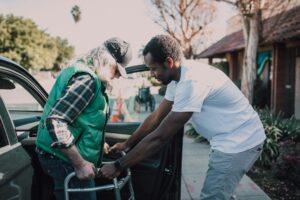In the 1970s, Michael Sykes, a trained engineer, stumbled upon one of the most significant innovations in house building by observing the natural process of thermal heating. He used thick-timber framing and mimicked the in and- out effect of heat in the atmosphere to create homes that made maximal use of passive solar energy. He called this “Enertia” — Energy from a shiftin- time. Since smart homes revolve, in large part, around the intelligent use and distribution of heating and cooling energy, whether from solar or other sources, we wanted to check in with Michael to find out more about the concept of his company, Enertia Homes — and its impact moving forward.
INNOVATION & TECHNOLOGY TODAY: How did the concept first come to you?
Michael Sykes: One Christmas Eve, I walked by a stack of large pine timbers that had been in the sun all day. I could feel the heat radiating from that pile — my light bulb moment. I knew this was the solution for storing energy in houses. It led to our double shell technique for moving the most energy into the most wood, without fans or electricity. The strength and violet-weather resistance is a side benefit of massive construction.
I&T TODAY: What makes a house smart?
MS: It reacts, acts, and adapts to changes, dampening their effect, without any input from the occupants, or controls, or sensors. This is done by design, and orientation, and is possible because the earth is tilted, and rotates. We divide the house into two shells, and the outer one is like an atmosphere, always trying to equalize like earth’s atmosphere with its trade winds. This equalization happens without mechanical equipment, or reliance on electricity or fuel.
I&T TODAY: That implies that most existing houses are dumb?
Michael Sykes: You could say that. I call them static, while the smart house is dynamic. Most houses today are built with “stick framing,” a method that dates from the 1890s. They are built to achieve a certain look or style, or for a certain number of bedrooms and baths. Stick framing is how you would build a false front on a movie set to look like a house — there is no inherent substance or strength. It’s all appearance. They must be conditioned by a furnace or air-conditioner to be habitable. One of our smart, dynamic homes conditions itself because that planetary tilt and rotation always creates differences between the two shells, and they want to equalize. A thermal connection with the moderate 55- degree earth means that with power out, or no fuel, that is as bad as it gets.
I&T TODAY:With all the advances in technology, why is housing still so antiquated?
MS: Unlike technology designed in labs, and built in factories, most houses are site-built by carpenters, who learned from their fathers, and grandfathers, and so on. Few of them even know this new housing technology exists, or is available. Our Enertia® homes are designed, or adapted, for each site and climate and manufactured in a factory with precision and control. Thus a carpenter can’t “ad-lib” and move a window or door on-site which might kill the thermodynamics.
I&T TODAY: Is the move towards “Green Building” making things better?
MS: Yes and no. Every design firm has gone green — they have to. But they focus on green features and materials that might, and I emphasize might, slow global warming or climate change if everybody does it. Instead, we focus on preparing your house for climate change — hardening the structure against superstorms and tornadoes, or making it function independently if the power grid is down for months, like in Hurricane Sandy.
I&T TODAY:What’s the worst thing about the prevalent types of houses?
Michael Sykes: That they are short-term, and don’t hold up. Way before the end of your mortgage, the insulation will be waterlogged, the nails rusty, and the particle board coming apart. If a storm or flood doesn’t get them first. Look at the rash of tornadoes, or the flooding in the Midwest. The first object of a house is to protect you, your family, and your possessions. Your house should be a place you run to in times of trouble, you will want your electronics and communications up and running. We have developed a proven system of raised-floor homes for the areas that will always have river flooding. You know it’s coming, so think ahead and build for it. When it’s over, our double shell airflow loop dries things out. Fifty percent of our population lives on the coast, within the range of a hurricane. The purpose of our design and construction method is to give you peace-of-mind and confidence in your shelter. Basic strength-of-structure, as well as design strategies to mitigate these climate and weather events, were our first criteria when we conceived the system. This led us to engineered Gluelams, the strongest assembly of wood known to man. Gluelam walls are up to ten times stronger than stick framing. Southern Pine Gluelams also have thermal inertia that flatlines at about 65 degrees, a perfect temperature for a dynamic smart house.
I&T TODAY: Is this where you got the name Enertia, from thermal inertia?
MS: Yes, it is a play on the term inertia. We changed the “i” to an “e” so we could get our trademark. Enertia is also a form-of-energy, defined as energy from a shift-in-time. The dynamic double shell structure moves solar energy from the day to night, and the massive structure stores that energy. It’s the opposite of the ‘airtight box’ approach most home designers are using now.









